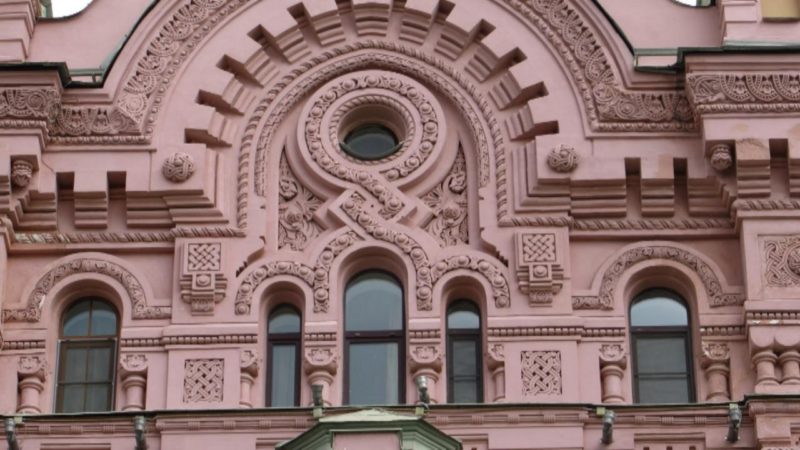The past centuries have preserved to our modern time magnificent monuments of architecture. They attract with their majestic serenity, to which one wants to touch. But not only a Russian architect is famous for a tree, stone and brick in his hand gave birth to true masterpieces. Would you like to be sure? We set out on the road!

**Mansion of the merchant AA Morozov, Moscow**
It was laid in 1894 by the architect V.A. Mazyrin. During the construction period,
building project. A.A. Morozov traveled a lot, but he was captivated by the beauty of the castles of Spain and Portugal. He wanted to build a building that looked like a castle from the Middle Ages, only in smaller scale. Five years later - in 1899 - the construction was over.
The castle was decorated with two towers with a balcony, on top of which was laid a beautiful lace attic. The entrance to the castle is shaped like a horseshoe, along the edges there are columns adorned with decor imitating the ship's ropes. On the wall of the front facade, sea shells, windows and the entrance doors are lined with arched and horseshoe arches. Mansion Rooms executed in Chinese, Italian, Moorish style.
**The Transfiguration Cathedral of the Monastery, Yaroslavl**
It was built in the twelfth century. In the XVIII century, the cathedral began to reconstruct under the the residence of the archbishops of Rostov and Yaroslavl. At the same time, a lot of new buildings - several towers, fences, belfry, Holy Gates.
Walking around the complex will be of interest to everyone who is interested in history, literature (namely here found "The Lay of Igor's Host"), as well as those who are inspired by architecture of the XII-XIX centuries.
**Cossack theater (the house of the merchant A. M. Shlykov), Volgograd**
The building, originally built by the merchant as a home for his family, is one of the best examples of "brick" style. Change plans a large forest merchant decided when drowned his daughter. After the completion of construction, to which the grieving father never lived, the house was handed over to the city, and a female gymnasium was located in it.
The building that survived during the war in the mid-90s was occupied by the Cossack Theater. Rich decor, bas-reliefs a young beauty and a formidable Poseidon - is not the only thing that can attract a merchant's house. Going legends that the girl's soul is still wandering along the corridors, and thrill-seekers looking for a meeting with her.
**Assumption Cathedral, Vladimir**
It was erected at the end of the 12th century under the rule of Prince Andrew Bogolyubsky. Four centuries later The cathedral, badly damaged by the Tatar-Mongolian raids, was redone in style Early Moscow architecture. The temple of restoration was also restored in the 20th century. The works began in 1926 year and ended only in 1961. On the walls of the cathedral preserved the whole church painting the middle of the XVI century, painted on the walls by Mark Matveyev. Now the temple of the Assumption rises next to the Golden Gate of the city of Vladimir. In the temple Bogolyubov icon of the Mother of God of the XII century is kept. Now in the Assumption Cathedral is functioning convent.
**Profitable house of N. P. Basin, St. Petersburg**
Not to notice this house, created back in 1878, is almost impossible. It has a bright- a marked similarity with the Russian theater. The house was nicknamed "cock" by contemporaries The merchant not only for decorating the façade with bas-reliefs of cocks, but also for the abundance of details that create a contrast to the Alexandrinsky Theater.
Two facades, an abundance of bay windows, like the interspersed motifs of "embroidery" and "carving" to see this house in person.
**Nevyanskaya leaning tower, Nevyansk**
An inclined building of nine floors, built by the order of Akinfiy Demidov, is easy to find. Four times an hour his bells are beating, and every three hours from the bell tower around the district spreads beautiful melody. The tower keeps many secrets. Who is its architect, why was she "shaken"? How could there be taken lightning rod, after all it was invented only in 1760? There are dozens of versions of answers to all these questions. The building is arranged so that in it the richest merchant could eavesdrop on his guests. Here he was engaged in business, made experiments, minted counterfeit coins ...
**Spaso-Yakovlevsky Monastery, Rostov**
Built in the fourteenth century complex - the main architectural landmark Of Rostov. It occupies a place on the shore of Lake Nero. Later they join him Zachatievskaya and Dmitrievskaya churches. In Zachatievsky temple of particular interest frescoes and the iconostasis of the 17th century. In the middle of the XVIII century it was decided to attach to Zachatievskaya the churches of Yakovlevskaya, which were reunited together.
**The Kremlin, Tobol'sk**
Built in 1686 after a large fire, the complex is the only Kremlin from stone on the Siberian land. Surrounded by a wall, the museum-reserve is also known for being here served and a reference to the order of B. Godunov's famous bell of Uglich, heralded the death Tsarevich Dmitry. A glance after visiting the complex in the city you will be able to the house where you lived The Romanovs are in exile.
All this and much more tourists can see to touch the history of their native country, visiting these and thousands of other towns and villages.